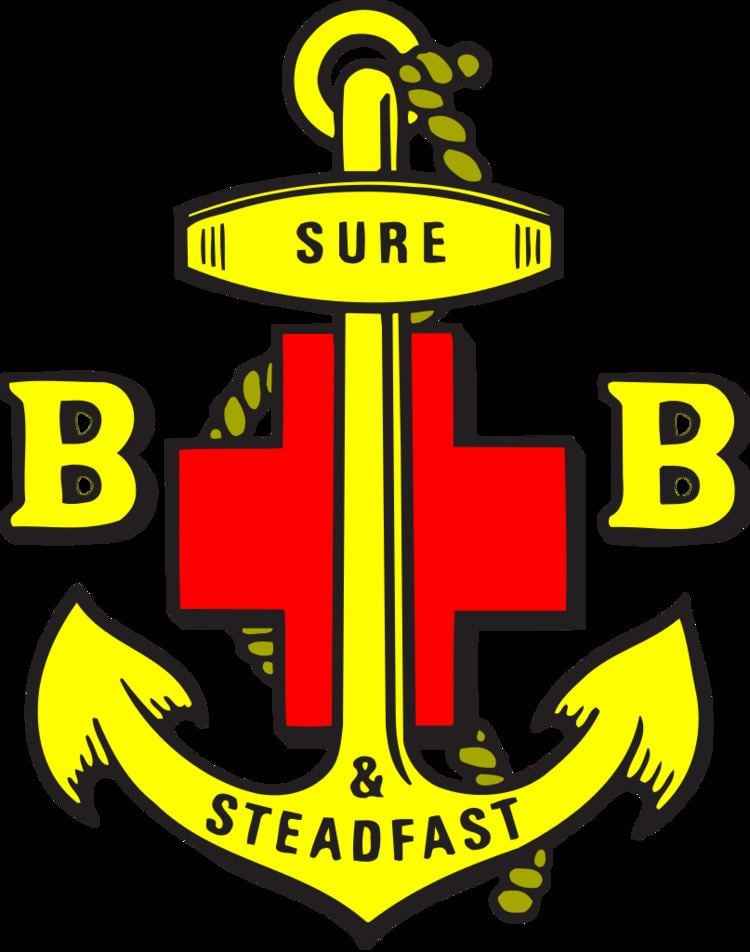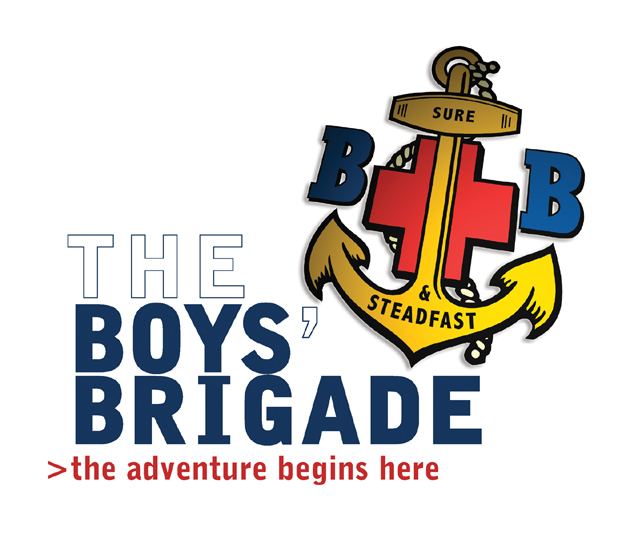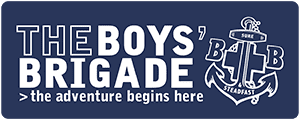Founded 4 October 1883 | Location Worldwide Area served International | |
 | ||
Founder Sir William Alexander Smith Members 50,000 (UK), 500,000 worldwide | ||
Boys brigade 9th coy fancy drill 2010 hd
For the 80s New Wave band from Canada, see Boys Brigade (band). Not to be confused with the Church Lads' and Church Girls' Brigade.
Contents
- Boys brigade 9th coy fancy drill 2010 hd
- Boys brigade will your anchor hold
- Object motto and emblem
- History
- Boys Brigade Scouts 1906 1927
- Merger with Boys Life Brigade 1926
- Establishment of recreational camping
- Sections in the BB
- Officers adult leaders
- Boys as Non Commissioned Officers
- Awards
- Anchor Section
- Junior Section
- Get the Credit
- Discover
- Challenge Plus
- Founders Badge
- Presidents Badge
- Queens Badge
- World Record Success
- Other countries
- References

The Boys' Brigade (BB) is an interdenominational Christian youth organisation, conceived by Sir William Alexander Smith to combine drill and fun activities with Christian values. Following its inception in Glasgow in 1883, the BB quickly spread across the United Kingdom and became a worldwide organisation by the early 1890s. As of 2003, there were 500,000 Boys' Brigade members in 60 countries.
Boys brigade will your anchor hold
Object, motto and emblem

The stated object of the Boys' Brigade is "The advancement of Christ's kingdom among Boys and the promotion of habits of Obedience, Reverence, Discipline, Self-respect and all that tends towards a true Christian manliness." Except for the addition of the word "obedience" in 1893, the contents of the object has remained unchanged from the beginning. However, some countries, particularly those which permit girls on their membership roll, have re-worded the object for gender neutrality. For example, in Malaysia, the word "manliness" has been changed to "character".

When designing the Brigade's motto and crest, William Smith referred directly to Hebrews 6:19 in the King James Version of the Bible, "Which hope we have as an anchor of the soul, both sure and stedfast...".
From this verse came the BB motto, "Sure and Stedfast", retaining the old spelling of the latter word. Today, some parts of the movement (only the UK and the ROI) have adopted the modern spelling of "steadfast", whilst all others continue to use the older spelling.

The crest was originally a plain anchor, bearing the BB motto with a capital 'B' on either side. Upon the merger between the Boys' Brigade and the Boys' Life Brigade in 1926, the red Greek cross was placed behind the anchor to form the current emblem. The cross originally formed part of emblem of the Boys' Life Brigade.
History
The Boys' Brigade was founded in Glasgow by Sir William Alexander Smith on 4 October 1883 to develop Christian manliness by the use of a semi-military discipline and order, gymnastics, summer camps and religious services and classes.
By 1910, there were about 2200 companies connected with different churches throughout the British Empire and the United States, with 10,000 officers and 100,000 boys.
Boys' Brigade Scouts - 1906-1927
Companies of The Boys' Brigade used manuals on scout training in their programs. In May 1903, Robert Baden-Powell became a vice-president. Baden-Powell promoted the idea of scouting and outdoor pursuits in the Boys' Brigade and other boys' organisations and schools. The Boys' Brigade formally began its boy scout scheme in 1906. Scout badges (Silver second class & Gold first class) were awarded in The Boys' Brigade and there were specialised Boys' Brigade Scout sections, which operated as part of a BB Company, but met at different times to train in scouting, who wore khaki or blue uniforms, neck scarves and the distinctive four dented broad brimmed fur felt hats. Boys of the Bournemouth & Poole Battalion of The Boys' Brigade participated in Baden-Powell's experimental camp on Brownsea Island in 1907. Baden-Powell did not originally intend to start a separate organisation. Many Boys' Brigade Scouts later made dual registration with The Boy Scouts Association. The 1st Bournemouth Scouts was run by the 1st Bournemouth Boys' Brigade as a 'BP' Scout group and never a 'BB Scout 'Section'. The Boys' Life Brigade, which merged with The Boys' Brigade in 1926, also operated its own boy scouts and was a member organization of the National Peace Scouts with the British Boy Scouts. The Boys' Brigade Scouts continued until 1927. Some former Boys' Brigade Scout units continued independently after 1927 or affiliated with The Boy Scouts' Association or British Boy Scouts. Two of the original Boys' Brigade Scout units continue as 1st Parkstone Scout Group and 1st Hamworthy Scout Group, both formerly sub units of the 1st Poole Boys Brigade.
Merger with Boys' Life Brigade - 1926
In October 1926 The Boys' Brigade united with The Boys' Life Brigade. The merger also prompted the abandonment of dummy drill rifles that had been used in The Boys' Brigade, due to the Life Brigade's objection to use of weapons or their representations. The Junior organisation of the Boys' Brigade prior to 1926 was called 'The Boy Reserves' but after amalgamation the juniors were called 'The Life Boys'. The name came from the fact that the junior reserve of The Boys' Life Brigade had been known as 'Lifeboys' (all one word). The Life Boys remained as the 'Junior Reserve of The Boys' Brigade until 1966 when the name was changed to 'The Junior Section'.
The Boys' Life Brigade (1899) was one of many similar movements formed following the formation of The Boys' Brigade. The BLB was formed by the National Sunday School Union (Pacifist) and was strongest amongst non-conformist churches. It substituted first aid drill for the military and weapons drill used in The Boys' Brigade. Others organisations similar to The Boys' Brigade included the Church Lads' Brigade (1891, Anglican) and London Diocesan Lads' Brigade (Anglican), the Catholic Boys' Brigade (1894) and the Jewish Lads' Brigade (1895). There were many more smaller Brigades in other denominations and even some in individual churches.
Establishment of recreational camping
Drawing from his military experience, William Smith (Knighted in 1909) introduced the concept of camping into the Brigade to allow boys and officers to remain in contact when other activities ceased for the summer break.
The notion was initially ill-received due to concerns for the boys' safety. A mother has been quoted saying, "Camp! My children have always had a roof over their heads, and as long as I live, always will!". They did have a roof over their heads because William Smith proceeded with the idea and 1st Glasgow Company held its inaugural one-week camp beginning on Friday, 16 July 1886, at Auchinlochan Hall, Tighnabruaich in a hall. In later years they took to canvas camping on a site at Portavadie in the Kyles of Bute. The First Glasgow continued to attend summer camp at the same location until the summer of 1974 when Portavadie was selected as the location of a proposed yard for the construction of oil production platforms. However the new camp is located only 100 yards away at Stilliag farm. This camp site is now used by many companies of the BB every summer for their camping trip.
The initial reservations towards camping did not last. A tradition developed, where the boys who were marching home on the last day of camp would be greeted by cheers from residents and were each presented with a bouquet of flowers. Camps soon became one of the most anticipated events in the year and early publications of the Boys' Brigade Gazette contained many accounts of camping experiences.
Sir William Smith's plans and notes for his first camps have been preserved, and have been used by many other campers.
Sections in the BB
There are five different age groups, known as "sections", within the organisation for the UK:
(Companies may choose to run a Girls' Association alongside or in combination with these sections)
Within Australia there are three sections known as:
Seniors is divided into 2 groups based on age. 12-14 Alpha and 15 - 18 Omega
Age groups are typically based on school years, so boys in the same year group would be promoted to the next section together, regardless of the dates of individual boys' birthdays. In some companies, sections may merge or there may be minor variations to the normal age boundaries, to accommodate excessively large or small groups of boys or a lack of leaders. Boys might also move to their next section before the end of the year to allow a smoother transition.
Amicus was launched in 1994, and is intended to either run as an alternative to the Seniors programme or even without any other Boys' or Girls' Brigade sections operating. Unlike other sections which may be for boys only in many companies, Amicus is always run as a mixed-gender group. The Amicus concept emphasises involvement of all its members in decision-making concerning the running of the section, such as the content and whether a uniform is to be worn. The section will be overseen and supervised by leaders aged over 18, who receive training from the Boys' Brigade and may deliver parts of the programme.
Malaysia has three age group which are
In the United Kingdom and Eire The BB is divided into 4 Regions, each region is then further divided. In Scotland and England & Wales The BB is divided into Districts and then Battalions. In Northern Ireland the BB is divided into 13 Battalions. The Battalions provide a local grouping of companies. The Battalions are normally based on Cities or Counties. Each Battalion has its own local structure that organises events and training on behalf of the member companies.
Officers (adult leaders)
Leaders in training are Warrant Officers, attaining the rank of Lieutenant only when having completed additional formal training in youth leadership. To avoid unnecessary leader hierarchy, all qualified officers are Lieutenants. The post of Captain of a company is a brevet rank with those in the position reverting to Lieutenant when they cease to be in the position; similarly other positions such as the company Adjutant (second to the captain) are considered appointments rather than substantive ranks.
Boys bearing the rank of Staff-Sergeant are non-commissioned officers but act within the company as Officers.
Boys as Non-Commissioned Officers
An older boy can gain promotion from Private to become a Non-Commissioned Officer (NCO). There are four NCO ranks available, each being awarded when a boy is of a certain minimum age and reaches a high enough standard of leadership:
NCOs often play an important role in the Boys' Brigade, helping the officers and other adult helpers with organising activities and awards classes, particular in the Anchors and Juniors sections. NCOs wear chevrons on their upper right arm.
Staff Sergeants act within the company as officers and do not stand in the ranks; however as Staff Sergeants are boys of the Brigade, they can still partake in company activities and competitions, and still earn awards and badges. The uniform of Staff Sergeants is slightly different from that of the normal boy or NCO, they wear still wear a blue shirt. If caps are worn, the BB Anchor is used with no coloured surround. Their rank is denoted with an armband on the right forearm with four inverted chevrons (similar to the rank badge historically worn by senior grades of sergeant in the British Army).
In the United Kingdom, those aged 17 to 21 years old who are nominated by their company, may participate in The Boys' Brigade KGVI Youth Leadership Training; this consists of two one-week-long residential training experiences containing all the training needed to become an officer in The Boys' Brigade. KGVI is held at each of the Regional Headquarters (Felden Lodge in England/Wales, Carronvale House in Scotland and Rathmore House in Northern Ireland).
Awards
Each section within the Boys' Brigade has awards that can be gained by fulfilling achievements.
Anchor Section
The Anchors can gain 3 badges: Green, Red and Blue triangles by completing a variety of activities in the areas of Body, Mind, Spirit, Community, and Creativity.
Junior Section
The Juniors award scheme was revised in 2004 and members of the section can now gain the Junior Target Award, followed by Bronze, Silver and Gold awards, by completing a variety of activities in the areas of Body, Mind, Spirit, Community, and Creativity.
Get the Credit
Under the old 'Get the Credit' Scheme, Company Section members could gain one Target badge first (reduced from the required two in an award reorganisation a few years ago, though Target Two could still be completed as an optional extra), then five other badges (Interests, Adventure, Leadership, Physical and Community) with red and blue flashes around them. After about three years, the boys would have gained all five badges with both red and blue flashes. This enabled the boys to attend a Leadership Training Course and potentially attain the President's Badge. This is a necessary prerequisite for the Brigade's highest award - the Queen's Badge.
Discover
The current award scheme for 11- to 15-year-olds, called Discover, was launched in August 2007. The award scheme is built around three 'zones': Community; Recreation; and Skills. Badges may be gained at four Levels in each zone, 1 through 4.
Having spent 2 hours working on topics relevant to each of the three zones (a total of 6 hours), the member is awarded the Compass Badge.
The badge for a zone is gained when the required number of hours have been spent working on topics relevant to that zone (Community - 7 hours; Recreation - 10 hours; Skills - 7 hours). A maximum of one badge per zone can be gained in a 12-month period (min 24 hours work). Any additional hours may not be carried over into the next 12-month period. In subsequent 12-month periods, members will work to gain Levels 2, 3, and 4 of each badge.
During a member's second year in Company Section they may gain the Discovery Badge, provided they have: gained a badge in all three zones within the last 12 months; completed an additional 6 hours work in any of the zones; taken part in a residential experience; played an active role in a Company, Battalion, or Church event; and had good attendance for the session.
The Discover programme includes the President's Badge, the requirements for which remain similar to those laid out in the 'Get the Credit' scheme. Including a 'Building Your Skills' Course
See images and logos at boys-brigade.org.uk.
Challenge Plus
The award scheme for Seniors (16- to 18-year-olds), is called Challenge Plus, and was launched in time for the start for the 2008/09 Session, and includes the Queen's Badge.
Founder's Badge
In non-Commonwealth countries, the Founder's Badge is used in place of the Queen's Badge. However, the Boys' Brigade in Malaysia and the Boys' Brigade in Singapore have chosen to use the Founder's Badge, although these countries are members of the Commonwealth.
President's Badge
President's badge is the second highest award in the senior section, it is also a requirement for members before undertaking the highest award which is Founder's badge. The title of Founder's Man and President's Man are held for life, recognizing all rounds of excellence in their service. The Badge itself may be worn while serving as a Non-Commissioned Officer (NCO), a Staff-Sergeant, or a Primer.
Queen's Badge
Queen's Badge is the highest award in the senior section in the UK and the Commonwealth, it is equivalent to a Founder's Badge.
World Record Success
From the 11–14 September 2014 members of the Boys' Brigade in Scotland took part in an attempt to set the world record for the longest ever game of five-a-side football. The team of 16 young people, plus their sizable support team, achieved a remarkable total of 55 hours playing time. They were awarded the Guinness World Record for longest marathon playing five-a-side football (soccer) in early 2015.
